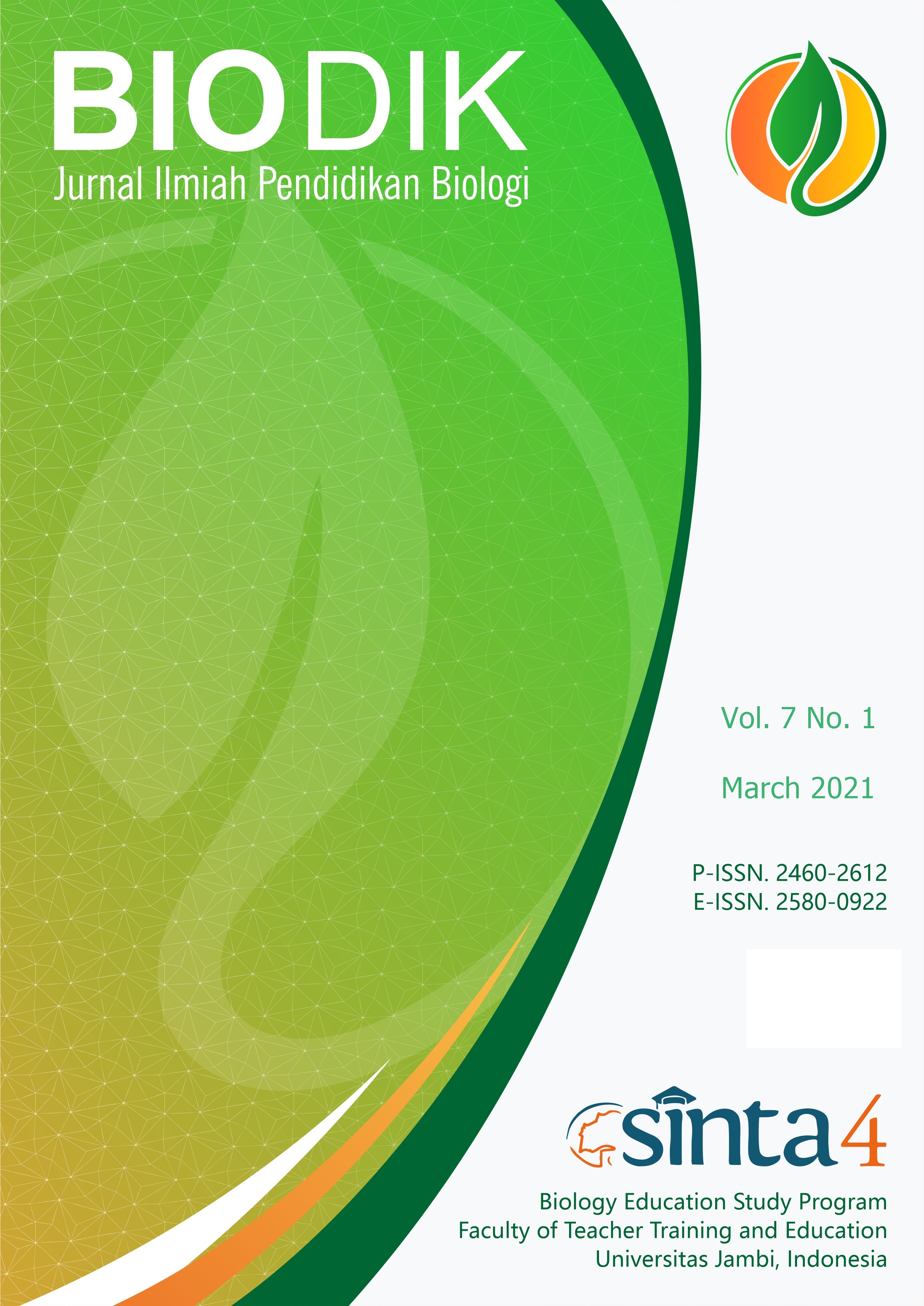Pengembangan Booklet Budidaya Jamur Edible Sebagai Bahan Ajar Mikologi
(Development of Edible Mushroom Cultivation Booklet as Mycology Teaching Materials)
DOI:
https://doi.org/10.22437/bio.v7i01.12063Abstract
This study aims to develop an edible mushroom cultivation booklet in the mycology course. The method used in this research is research and development using the ADDIE model. This research was conducted with the stages of analysis, design, development, implementation, and evaluation. Based on the results of the study, it shows that the feasibility of the booklet used is declared feasible according to the results of media validation and material validation by the validator team. On the results of the first media validation with a score of 75% "good" and the second media validation is 90% "very good". While the results of the validation of the first material with a score of 70 "good" and the result of the second validation is 90 "very good". After the assessment was carried out by the validator team, then the booklet was tested with small groups and large groups of biology education students. Based on the results of the small group student response test, it was found that 91.5% was included in the "very good" category, and the results of the large group student responses obtained a percentage of 98.3% included in the "very good" category. The results showed that the edible mushroom cultivation booklet developed was suitable for use as a learning resource, able to foster interest and entrepreneurial spirit for Biology Education Students of Jambi University.
Abstrak. Penelitian ini bertujuan mengembangkan booklet budidaya jamur edible pada mata kuliah mikologi. Metode yang digunakan pada penelitian ini yaitu penelitian dan pengembangan dengan menggunakan model ADDIE. Penelitian ini dilakukan dengan tahap analysis, design, development, implementation, dan evaluation. Berdasarkan hasil penelitian menunjukkan bahwa kelayakan terhadap booklet yang digunakan dinyatakan layak sesuai hasil dari validasi media dan validasi materi oleh tim validator. Pada hasil validasi media ke-1 dengan skor 75% “baik†dan validasi media yang ke-2 yaitu 90% “sangat baikâ€. Sedangkan hasil validasi materi yang ke-1 dengan skor 70 “baik†dan hasil validasi yang ke-2 yaitu 90 “sangat baikâ€. Setelah dilakukan penilaian oleh tim validator selanjutnya booklet dilakukan ujicoba dengan kelompok kecil dan kelompok besar terhadap mahasiswa pendidikan biologi. Berdasarkan hasil dari uji respon mahasiswa kelompok kecil diperoleh persentase 91,5% termasuk dalam kategori “sangat baikâ€, dan hasil respon siswa kelompok besar diperoleh persentase 98,3% yang termasuk dalam kategori “sangat baikâ€. Hasil penelitian menunjukkan bahwa booklet budidaya jamur edible yang dikembangkan layak digunakan sebagai sumber belajar, mampu menumbuhkan minat dan jiwa entreprenership bagi Mahasiswa Pendidikan Biologi Universitas Jambi.
Downloads
References
Achmad, M., Arlianti, T., dan Azmi, C. 2013. Panduan Lengkap Jamur. Jakarta: Penebar Swadaya
Arsyad dan Azhar. 2011. Media Pembelajaran. Jakarta: PT Raja Grafindo Persada
Depdiknas. 2008. Panduan Pengembangan Bahan Ajar. Jakarta: Direktorat Pembinaan Sekolah Menengah Atas.
Dikti. 2009. Pedoman Operasional Penilaian Angka Kredit Kenaikan JabatanFungsional Dosen ke Lektor Kepala dan Guru Besar. Jakarta:Kemendiknas
Firdaus, M dan Wilujeng, I. 2018. Pengembangan LKPD inkuiri terbimbing untuk meningkatkan keterampilan berpikir kritis dan hasil belajar peserta didik. Jurnal inovasi pendidikan IPA. 4(1): 26-40
Mintarti. 2011. Efektifitas Booklet Makjan Sebagai Media Pembelajaran Untuk Meningkatkan Perilaku Berusaha Bagi Pedagang Makanan Jajanan. Tesis: ITB. Bogor
Pralisaputri K. R., Soegiyanto H., Muryani C. 2016. Pengembangan Media Booklet Berbasis SETS Pada Media Pokok Mitigasi dan Adaptasi Bencana Alam Untuk Kelas X SMA. Jurnal GeoEco, 2(2): 147-154.
Prastowo, A. 2012. Panduan Kreatif Membuat Bahan Ajar Inovatif. Yogyakarta:DIVA Press
Pratowo, A. 2011. Pengembangan Bahan Ajar Tematik; Tinjauna Teoritis dan Praktis. Jakarta: Kencana Prenadamedia Group.
Riduwan. 2011. Belajar Mudah Penelitian untuk Guru, Karyawan, dan Peneliti Pemula. Bandung: alfabeta.
Rohaeti, E., LFX, E.W dan Padmaningrum, R.T. 2009. Pengembanagan lembar kerja siswa (LKS) mata pelajaran sains kimia untuk SMP. Jurnal Inovasi Pendidikan. 10(1).
Suwarni, E. 2015. Pengembangan Buku Ajar Berbasis Lokal Materi Keanekaragaman Laba-Laba Di Kota Metro Sebagai Sumber Belajar Alternatif Biologi Untuk Siswa SMA Kelas X. Jurnal Bioedukasi Vol. 6(2):13-22.
Downloads
Published
Versions
- 2021-03-14 (2)
- 2021-03-14 (1)
How to Cite
Issue
Section
License
Copyright (c) 2021 Harlis, Retni S. Budiarti, Desfaur Natalia

This work is licensed under a Creative Commons Attribution-NonCommercial-ShareAlike 4.0 International License.
Copyright Notice
Authors who publish with Biodik : Jurnal Ilmiah Pendidikan Biologi agree to the following terms:
- For all articles published in Biodik : Jurnal Ilmiah Pendidikan Biologi, copyright is retained by the authors and grant the journal right of first publication with the work simultaneously licensed under a Creative Commons Attribution-ShareAlike 4.0 International Licensethat allows others to share the work with an acknowledgment of the work's authorship and initial publication in this journal.
- Authors are able to enter into separate, additional contractual arrangements for the non-exclusive distribution of the journal's published version of the work (e.g., post it to an institutional repository or publish it in a book), with an acknowledgment of its initial publication in this journal.
- Authors are permitted and encouraged to post their work online (e.g., in institutional repositories or on their website) prior to and during the submission process, as it can lead to productive exchanges, as well as earlier and greater citation of published work (See The Effect of Open Access).
















